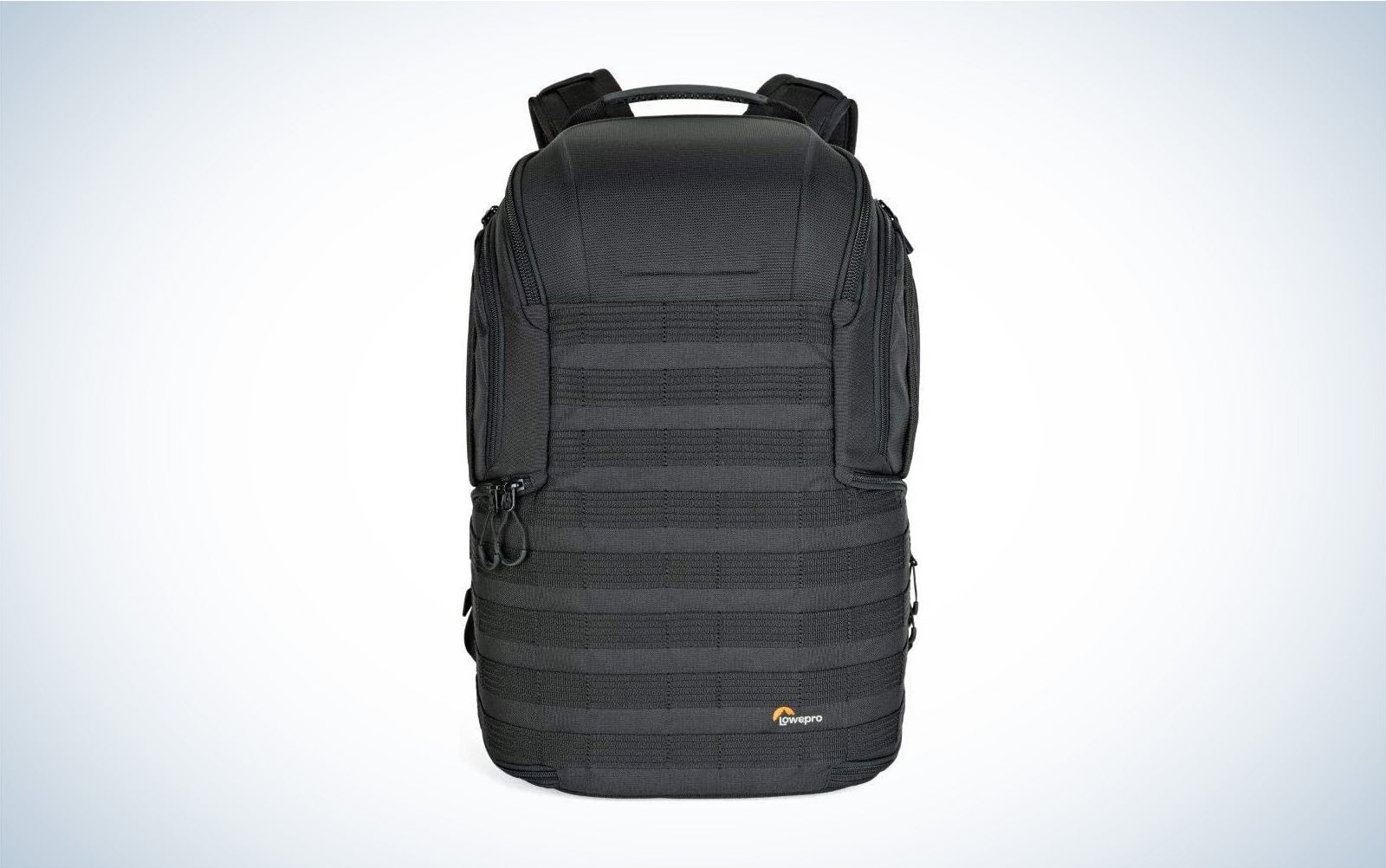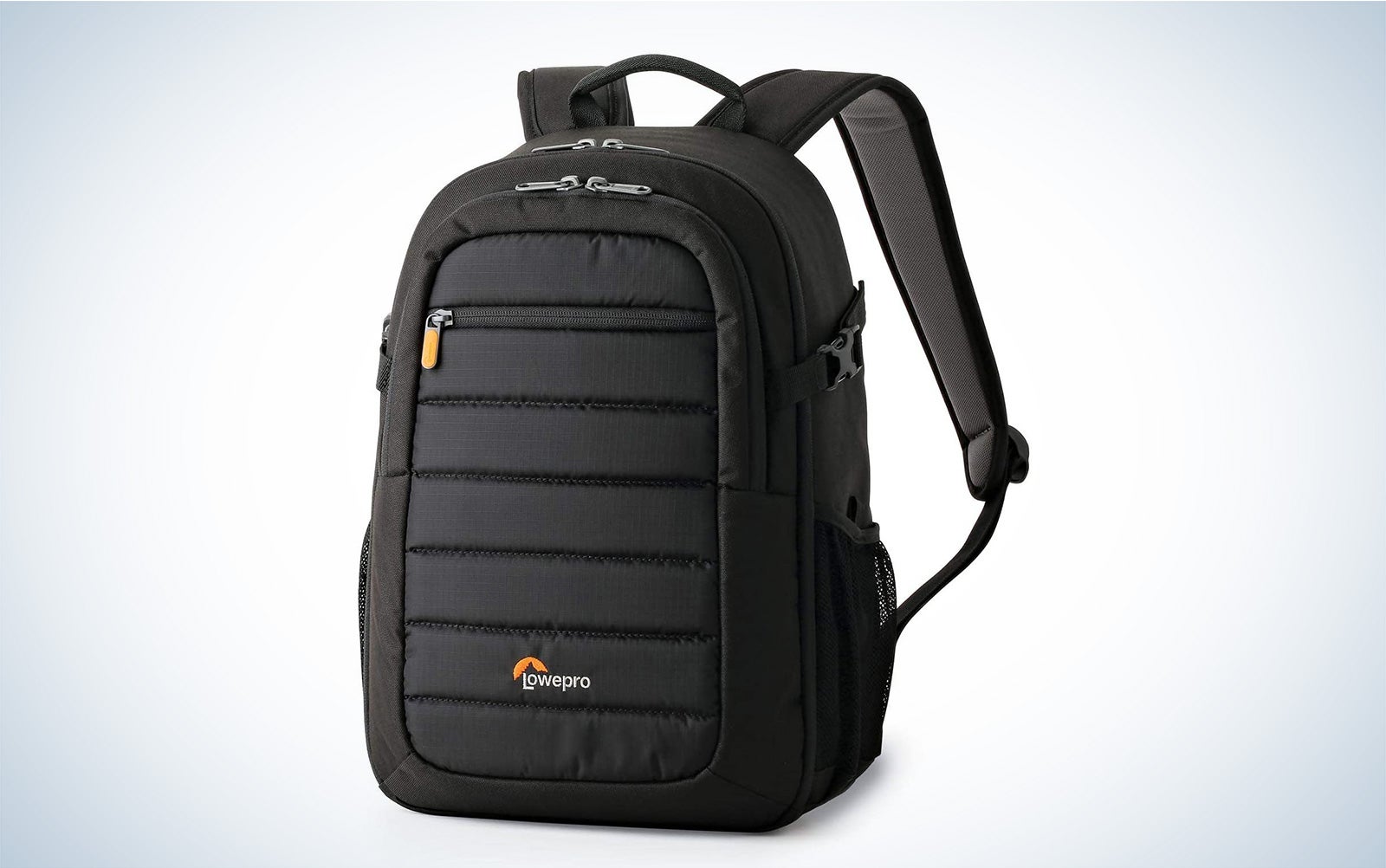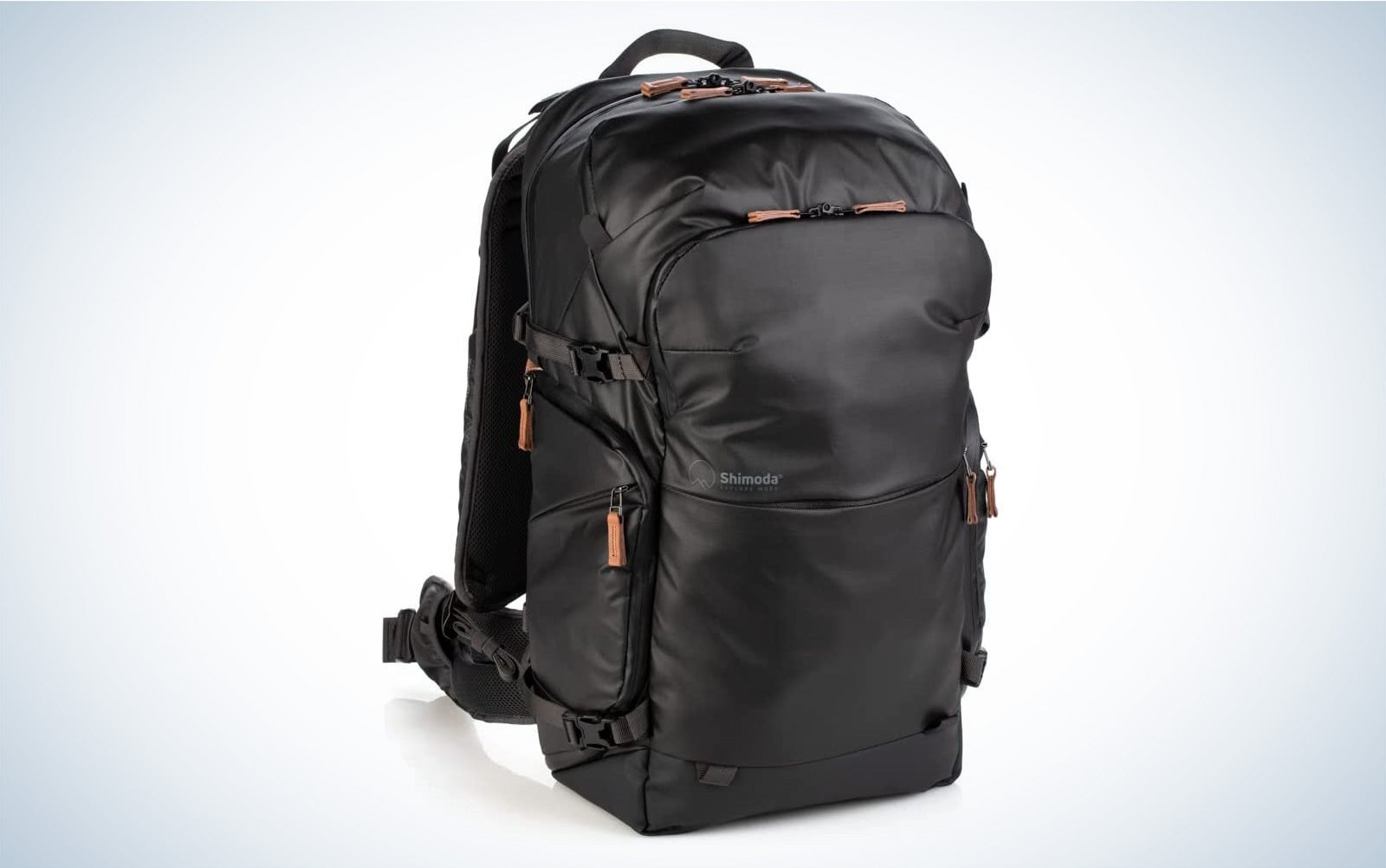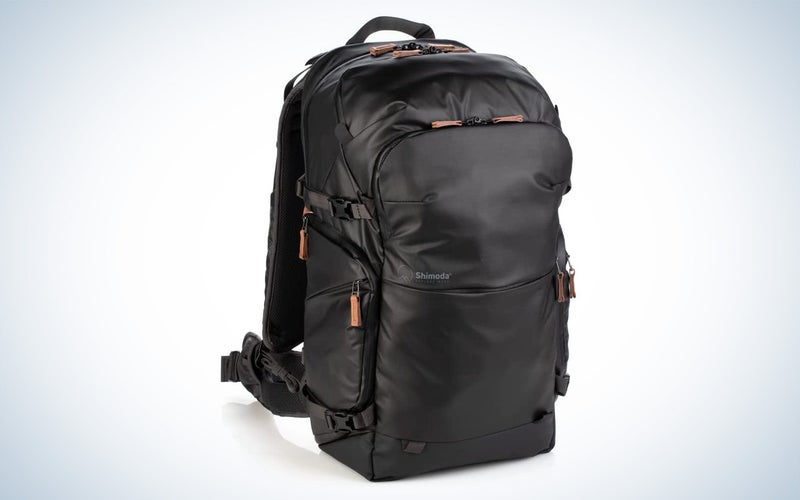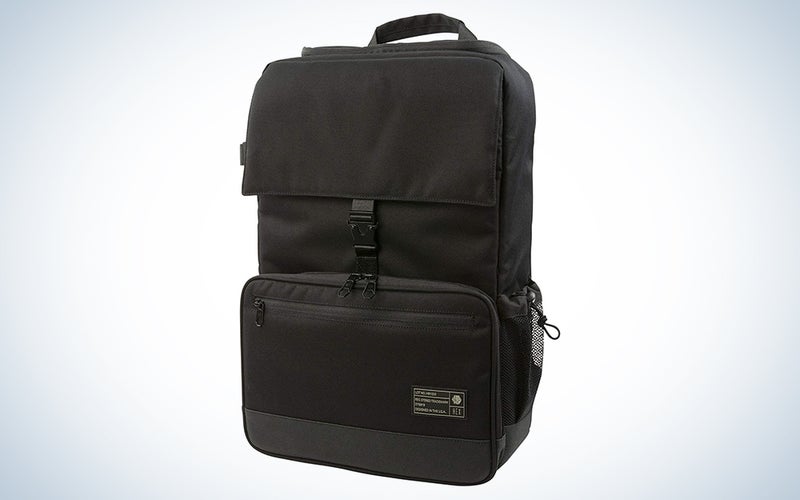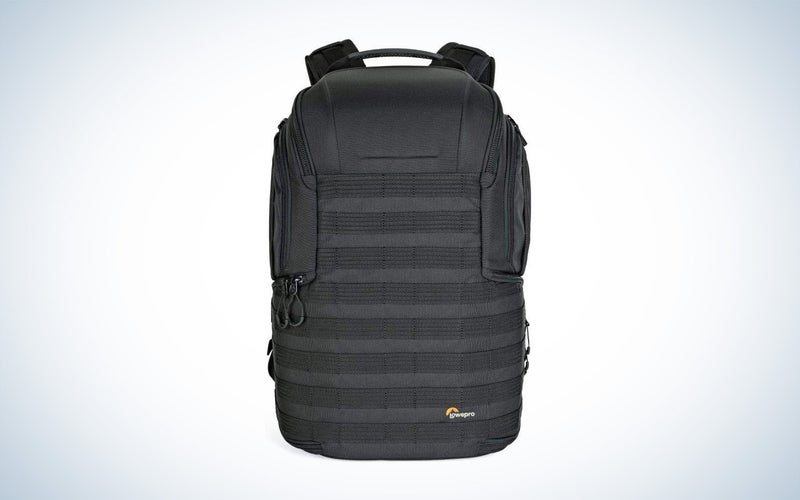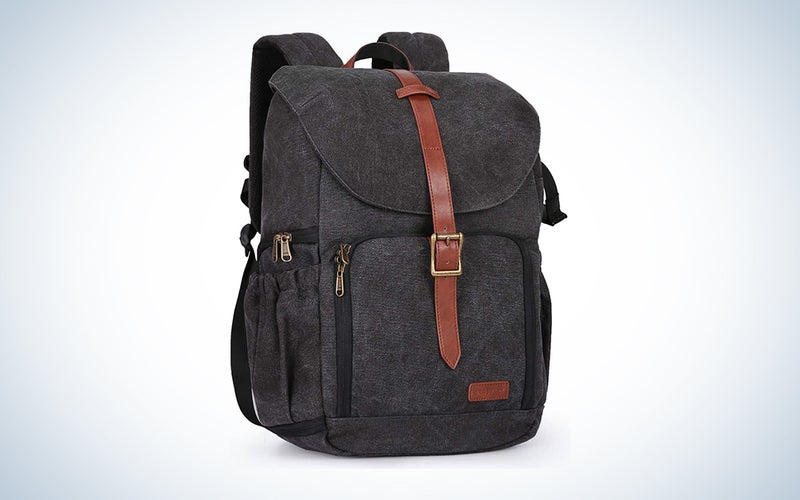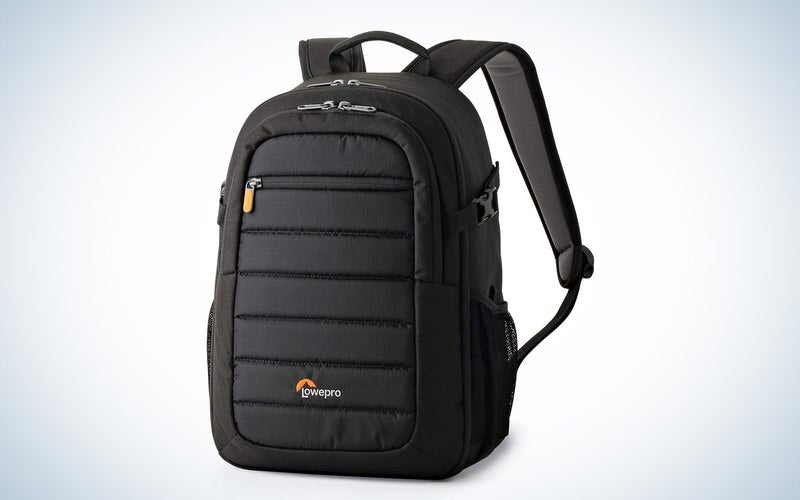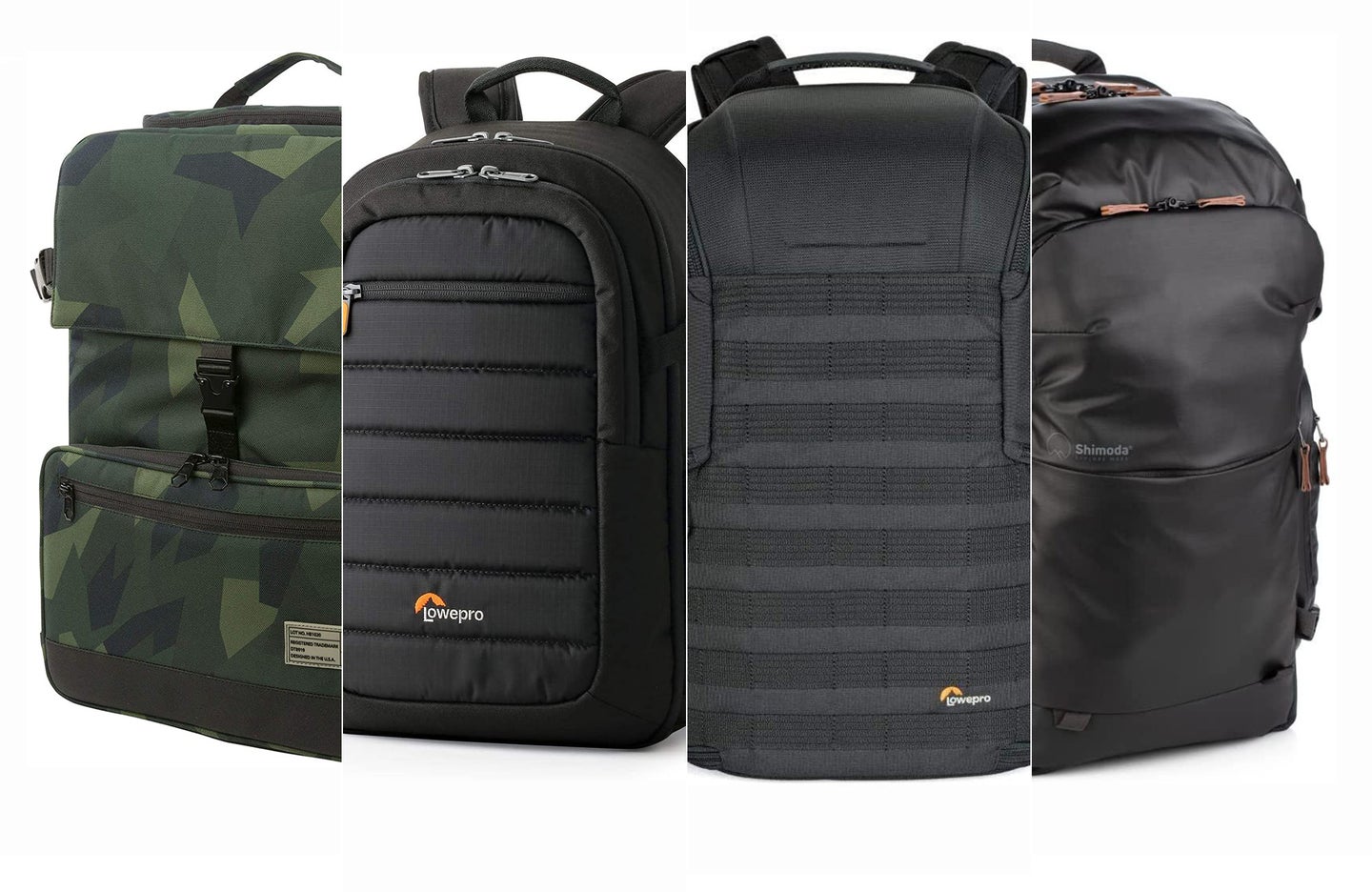
We may earn revenue from the products available on this page and participate in affiliate programs. Learn more ›
Camera gear isn’t cheap, so it deserves a safe, secure method for moving it around. Camera backpacks have been lugging precious photographic loads around for generations and they have only gotten better with time. The best camera backpacks offer tons of storage, ample padding, supportive straps, and thoughtful features that make lugging your camera simple, even on long adventures. We’ve curated this list of camera bags to address a variety of loads and shooting styles. While many of the bags on this list of best camera backpacks require a bit of an investment up-front, you’ll thank yourself later when your bag takes a tumble or whack and your gear stays safe and sound.
- Best for hiking: Shimoda V2 Explore
- Best for DSLR: HEX Backloader DSLR Backpack
- Best for professionals: Lowepro ProTactic 450 AW II
- Best anti-theft: BAGSMART Camera Backpack, Anti-Theft Camera Bag
- Best budget: Lowepro Tahoe BP 150
How we picked the best camera backpacks
The editors and writers at PopPhoto have been enthusiast and professional photographers for decades. I’ve worked as a professional photographer for more than 15 years, most of which involved lugging a backpack full of gear around with me. We have personally tested most of the models on this list, which started off with dozens of options. We also relied on spec comparisons, editorial reviews, and user feedback to choose the best models. Even our budget model isn’t exactly cheap, and that’s because we believe it’s worth spending some money to get a bag that will truly protect your gear in a variety of situations. Spending an extra $50 at the outset will seem like a deal if it saves your expensive bodies and lenses from a hard fall or intense storm.
Features to consider when shopping for the best camera backpack
You’ll find hundreds, if not thousands of camera backpack options on the market at the moment. They come in a variety of sizes, protection levels, and prices. Here are some of the most important things to consider when choosing a backpack for your gear.
Capacity
Most camera bags offer dedicated laptop sleeve and a section for storing camera gear so they don’t clash in transit. When shopping for a new camera backpack, it is important to consider the size of your gear, how much gear you will be traveling with, and any camera accessories you might be bringing along. Some bags aren’t long enough to accommodate a large zoom lens, and if you’re shooting with a full-sized camera like the Canon 1D X Mark III or your camera has a vertical grip installed, some bags may be too shallow to fit the extra height. Take an extra few minutes to measure your gear (or just look up the dimensions online) and compare them to the bag dimensions.
Opening type
Camera backpacks typically come with either a clamshell design or a roll top design. A roll top design is usually better at holding more stuff, while a clamshell backpack has a more understated, stylish design. A lay flat configuration of the backpack can be extremely helpful when flying because it makes it much easier to get through security, but can also be useful in the studio. If you are looking for a backpack where you can access your gear while the camera backpack remains on your body, look for something with side access pockets instead.
Some lay-flat bags open on the back while others open on the front. I prefer those that open on the back because you can lay it on the ground without getting dirt allover the part of the bag that touches your body.
Ruggedness and weatherproofing
If you are primarily using the camera backpack for commuting with your gear you probably won’t need a fully waterproof camera backpack—something that is water-resistant will likely be plenty of protection. If you are planning to take your camera gear on long hikes in the elements, a fully weatherproof camera backpack with a dedicated rainfly will be a better option for you. Think about how you will be using the bag to help determine which camera backpack is best.
Traveling by air or commuting to work is a very different environment than taking your camera equipment into the outdoors. If you are an avid outdoor photographer who plans to take your gear on lots of outdoor adventures in rugged terrain, you will likely want to look for a camera backpack that can handle the unpredictable elements of the outdoors.
If you are planning to do a lot of hiking with your camera equipment, look for backpacks with a larger capacity and that have enhanced weatherproofing to keep the contents of your camera backpack safe.
Some camera bags come with removable rain socks that stow away inside the bag and fold out for when the weather gets particularly gnarly.
Gear size
If you are shooting with a DSLR camera consider that the body, the lenses, and all of the accessories will be larger and heavier than if you are a mirrorless photographer. A camera backpack specifically designed for larger DSLR cameras is a great way to make sure that weight is evenly distributed in your backpack, while still keeping all of your gear safe and sound.
If you are traveling with two bodies and a variety of lens options selecting a camera backpack that loads from the back is a great choice. With these designs, the entire back panel of the bag is where you will store your gear. Accessing the gear typically means removing the pack from your back. This style of camera backpack allows you to carry a whole lot more lenses and accessories while you are traveling with your camera gear.
Best for hiking: Best camera backpack for hiking: Shimoda V2 Explore
Shimoda
Why it made the cut: A clever, modular storage system and very versatile straps make this a fantastic way to carry lots of gear for long treks over gnarly terrain.
Specs:
- Weight: 7.8 x 11.6 x 21.2 inches
- Support straps: Waist and chest
- Dimensions: 4.4 pounds
Pros:
- Extremely comfortable
- Clever modular storage system
- Burly weatherproofing
- Lots of pockets
Cons:
- Pricey
We gave the Shimoda V2 Explore a 2021 Pop Award last year. In other words, it’s one of the best camera bags we’ve ever used. This outdoor-oriented bag relies on modular inserts to arrange the compartment specifically for your preferred gear loadout. The straps—including the waist and chest straps—adjust so it can conform to people of different heights. That makes this bag great for men or women of any size or height.
It has enough capacity to fit a full-sized laptop, and outer pockets hold a water bottle and tripod. It opens on the side closest to your back, so you can put it down on the trail without worrying about it getting your clothes wet or dirty when you pick it back up. Plus, it has multiple access points for the gear compartment. You may not even have to put it down at all to grab your camera.
Best for DSLRs: HEX Backloader DSLR Backpack
Amazon
Why it made the cut: Its boxy design makes lots of room inside for larger camera rigs.
Specs:
- Weight: 3.25 pounds
- Support straps: Chest
- Dimensions: 18.5″ H x 12.0″ W x 5.5″ D
Pros:
- Lots of room for gear
- Sturdy, modular padding
- Understated design doesn’t scream “camera bag”
Cons:
- No waist strap
This backloading DSLR bag’s camera storage section takes up the entire back of the bag. That gives it lots of room for multiple camera lenses and accessories. The back compartment is lined with customizable EVA foam inserts and velcro to configure your bag however you like. A quick-access pocket at the top of the bag makes it so you can grab the camera body without having to unzip the rest of the bag. This compartment has three large interior pockets for holding extra batteries, cables, memory cards, and other accessories. The front of the bag features a large pocket for storing keys, phone, or other personal items. It has a fleece-lined 15-inch laptop sleeve, a water bottle pocket, plus a place to attach a tripod. It offers a solid mix of space and protection, so it’s great for photographers that need to carry a lot of gear.
Best for professionals: Lowepro ProTactic 450 AW II
Lowepro
Why it made the cut: A super-burly bag with enough room for a pro kit gets a boost from lots of extra purpose-driven pockets.
Specs:
- Weight: 5.94 pounds
- Support straps: Waist and chest
- Dimensions: 6.3 x 17.32 x 11.81 inches
Pros:
- Sturdy straps with waist and chest support
- Robust padding and an EVA shell for extra protection
- Lots of room for gear
- Thoughtful pocket design
- Weatherproof
Cons:
- Heavy
Lowepro’s pro-grade camera bag has the plush padding you’d typically expect from a high-end camera backpack. However, it also offers a molded shell of EVA foam around the exterior to provide a sturdy extra layer of protection on top of the squishy foam. That adds impact resistance, but it also makes the bag more resistant to rain and other precipitation. The AW in the name stands for All-Weather, and it really lives up to that name. The back compartment runs the entire length of the bag so it has enough room for pro gear like larger zoom lenses or pro bodies. It can fit a 15-inch laptop and an array of other accessories and snacks so you won’t go hungry on a long shoot.
Best anti-theft: BAGSMART Camera Backpack, Anti-Theft Camera Bag
Amazon
Why it made the cut:
Specs:
- Weight:
- Support straps:
- Dimensions:
Pros:
- TK
Cons:
- TK
This anti-theft camera backpack looks unassuming on the outside, but it’s packed with anti-theft features. It features lockable zippers for increased safety when traveling with your gear through crowded tourist destinations. The lower zone of the bag holds a day’s worth of camera equipment. The top section stores clothes and personal items. A separate padded sleeve comfortably hugs laptops up to 15 inches. The camera section is large enough to hold a DSLR with attached 70 to 200mm lens or 3 to 4 standard lenses. There are large side pockets on both sides for a water bottle and/or a tripod. The bag allows you to hook all of the zippers together and secure them together to ingress more difficult. It’s made of water-resistant canvas and has a dedicated rain cover too so it’s not afraid of the weather.
Best budget: Lowepro Tahoe BP 150
Lowepro
Why it made the cut: It’s affordable, but not built cheap, which means it will still protect your kit without destroying your budget.
Specs:
- Weight: 1.76 lbs.
- Support straps: None
- Dimensions: 10.83 x 8.54 x 15.87 in.
Pros:
- Affordable
- Solid padding
- Lightweight
- Sturdy zippers and handle
Cons:
- Doesn’t fit a ton of gear
- No extra support straps
This bag offers a compact design, but offers enough room for small kits. Think a mirrorless cameras or a DSLR with a lens or two. For many shooters, however, that’s all they really need. Unlike some other “budget” picks, it doesn’t skimp on the padding or the build-quality. It has burly zippers that won’t separate or lose their pulls. The thick padding is sturdy, too, which means it won’t crush under a little bit of weight. The design is extremely basic, but there is plenty of room in the front pocket and on top for accessories. The padding isn’t as thick as other options, but it’s also not skimpy.
FAQs
Q: Why do you need a camera bag?
Having a camera bag is the easiest way to keep your gear safe while you are traveling with it. Lenses and camera bodies are expensive and having a dedicated bag to store your gear in when you aren’t shooting with it helps ensure that your gear stays in good condition. A camera bag keeps your gear safe from bad weather and would-be thieves.
Q:
What makes a good camera backpack?
The best camera backpacks will evenly distribute the weight of your gear across your body, have a dedicated padded compartment for holding your gear, some amount of weather-proofing, and a dedicated laptop sleeve. Look for one with extra pockets for holding personal items and multiple points of entry to make it easy to access your camera gear without having to remove the camera backpack.
Q:
What is the best waterproof camera backpack?
Most camera backpacks feature some amount of weather-proofing, but if you are looking for a fully waterproof bag, your best bet is to go with something meant for outdoor photographers. Camera bags that are designed to be taken on hikes will feature the best waterproofing and often come with a dedicated rain fly that you can cover the bag in case of a storm.
A final word on shopping for the best camera backpack
Finding the best camera backpack for you depends a lot on how much gear you will be carrying with you, the size of your camera equipment, and where you are planning to travel with your gear. The majority of camera backpacks feature a dedicated laptop sleeve and enough space for a mirrorless camera setup or a DSLR setup. A design with a dedicated layout laptop sleeve will make it easier to get through airport security, while a camera backpack with a backloading design will allow you to carry more gear.
A camera backpack designed for exploring the outdoors will feature more impressive waterproofing than a backpack made for urban commuting or day-to-day use. A camera backpack with more advanced features will likely be more expensive than a basic camera backpack, but will also stand up to more wear and tear. Regardless of the bag you choose, having a dedicated camera backpack is a great way to keep your favorite camera equipment safe and secure.
The post The best camera backpacks for 2023 appeared first on Popular Photography.
Articles may contain affiliate links which enable us to share in the revenue of any purchases made.
